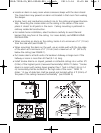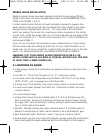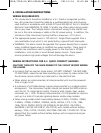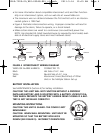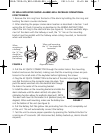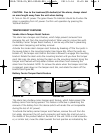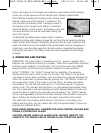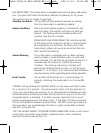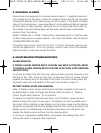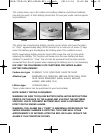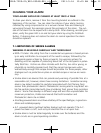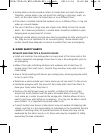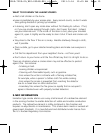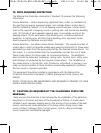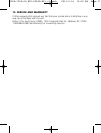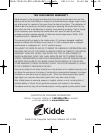CLEANING YOUR ALARM
YOUR ALARM SHOULD BE CLEANED AT LEAST ONCE A YEAR
To clean your alarm, remove it from the mounting bracket as outlined in the
beginning of this section. You can clean the interior of your alarm (sensing
chamber) by using compressed air or a vacuum cleaner hose and blowing or
vacuuming through the openings around the perimeter of the alarm. The out-
side of the alarm can be wiped with a damp cloth. After cleaning, reinstall your
alarm, verify the green LED is on and test your alarm by using the Test/Hush
Button. If cleaning does not restore the alarm to normal operation the alarm
should be replaced.
7. LIMITATIONS OF SMOKE ALARMS
WARNING: PLEASE READ CAREFULLY AND THOROUGHLY
• NFPA 72 states: Life safety from fire in residential occupancies is based primari-
ly on early notification to occupants of the need to escape, followed by the
appropriate egress actions by those occupants. Fire warning systems for
dwelling units are capable of protecting about half of the occupants in poten-
tially fatal fires. Victims are often intimate with the fire, too old or young, or
physically or mentally impaired such that they cannot escape even when
warned early enough that escape should be possible. For these people, other
strategies such as protection-in-place or assisted escape or rescue are neces-
sary.
• Smoke alarms are devices that can provide early warning of possible fires at a
reasonable cost; however, alarms have sensing limitations. Ionization sensing
alarms may detect invisible fire particles (associated with fast flaming fires)
sooner than photoelectric alarms. Photoelectric sensing alarms may detect visi-
ble fire particles (associated with slow smoldering fires) sooner than ionization
alarms. Home fires develop in different ways and are often unpredictable. For
maximum protection, Kidde recommends that both Ionization and
Photoelectric alarms be installed.
• A battery powered alarmmust havea battery ofthe specifiedtype, in goodcon-
dition andinstalled properly.
• A.C. powered alarms (without battery backup) will not operate if the A.C.
power has been cut off, such as by an electrical fire or an open fuse.
• Smoke alarms must be tested regularly to make sure the batteries and the
alarm circuits are in good operating condition.
1260-7205-01(820-0394G-EN)_v1.qxd:_ 2011.5.16 10:15 AM Page 13



